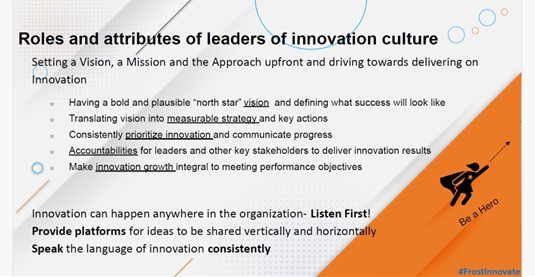Introduction
Innovation leaders from around the country recently gathered for The DuPont Silicon Valley Technology Center Innovation Workshop and Tour. This unique learning and networking event included a tour of the DuPont Silicon Valley Technology Center in Sunnyvale, California. Participants enjoyed a full day of dynamic presentations and interactive panels, highlighted by a tour of the center, a vibrant haven that encourages innovators and customers to test limits and explore new digital applications and technologies.
The event was produced by Frost & Sullivan’s Growth Innovation Leadership Council, whose members received a summary of all the workshop sessions. Read on for an excerpt from that takeaways document, highlighting the opening headliner presentation on Cultivating an Innovation-Centric Culture, given by Rangarajan Sampath, Senior Vice President and Head of the Center for Innovation in Diagnostics (CID), Siemens Healthcare Diagnostics, Incorporated.
Session summary
In today’s dynamic business landscape, fostering innovation has become a paramount objective for organizations looking to thrive and remain relevant. Rangarajan Sampath, a seasoned professional who is renowned for his visionary leadership and groundbreaking contributions to the fields of medical technologies, explored the critical role of C-Suites in shaping an innovation culture that permeates the entire organization from the top down. Through examples and discussion, he delved into the mindset shift required to embrace innovation as a strategic priority.
Sampath told participants that they needed to understand their personal definitions of innovation. He suggested that they determine whether they had a culture that supported innovation, and if so, why…or why not? He asked the audience, “What does innovation mean to you? Is it a new or better way to solve a problem?” Sampath noted that when he explores the topic of innovation with leaders, very often what’s missing is an innovation culture or framework. To start, leaders need to set a clear vision. Then, innovation initiatives should be continuous and supported throughout the company. Incorporate innovation into performance reviews, set expectations.
To operationalize this, consider approaching innovation in three different stages – near-term, mid-term and long-term growth. Measure and monitor milestones and progress. Set a plan. Establish a baseline and talk about it. Most companies fail because they don’t take risks. To counter this, provide an environment for growth and plant the seeds for innovation:
- Be bold. Have a vision to share with your colleagues.
- Build the vision. What is the internal strategy? What are the key actions? Get buy-in.
- Prioritize consistently. Always communicate the progress with your teams and stakeholders.
- Provide a platform for customers and employees to freely share ideas. Keep messaging consistent.
- Have a mechanism where ideas are fostered. How will you continually prioritize and keep interest alive?

Innovation Leadership Model
A leadership model is also important. Sampath’s leadership model is made up of three parts that move in tandem with each other:
- Define the brand and strategy.
- Shore up your culture and staff resources.
- Refine processes and governance. Make sure you have processes in place that will help your innovations succeed. Create a project roadmap.
Remember, it’s critical to review your strategy each year and to change the innovation ideation focus when necessary. Determine a time to pick the five most critical projects and measure whether you’re on the right track. Ask yourself and your team – should you continue? Don’t be afraid, but make sure you know when you should stop.
Ranga is a seasoned professional who is renowned for his visionary leadership and groundbreaking contributions to the fields of medical technologies, in-vitro diagnostics, and digital health solutions. His extensive experience in diverse corporate settings has made him believe in the power of fostering a culture of innovation, collaboration and inclusivity. As a thought leader, he continues to be a driving force behind positive change, pushing the boundaries of what is possible in the pursuit of better health and a brighter future for all.


Recent Comments